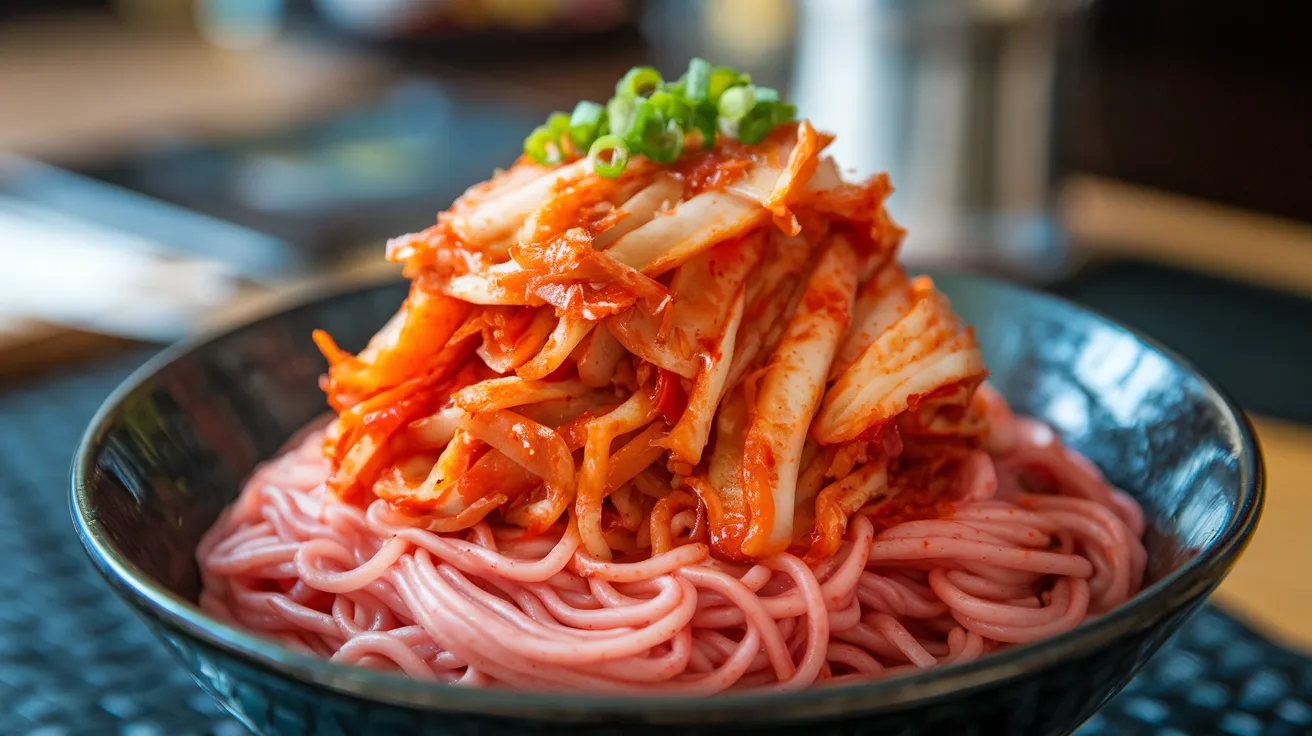Kimchi noodles bring together the bold, spicy flavors of traditional Korean kimchi with the comforting texture of noodles, creating a perfect fusion of heat and heartiness.
Whether served hot in a broth or cold as a salad, this dish is packed with umami-rich fermented goodness that adds depth to every bite.
Kimchi, known for its tangy spice and probiotic benefits, pairs wonderfully with various types of noodles, from chewy ramen to slippery udon or thin rice noodles..
Check out my 15 faves!
The 15 Best kimchi noodles
1. Kimchi Ramyeon
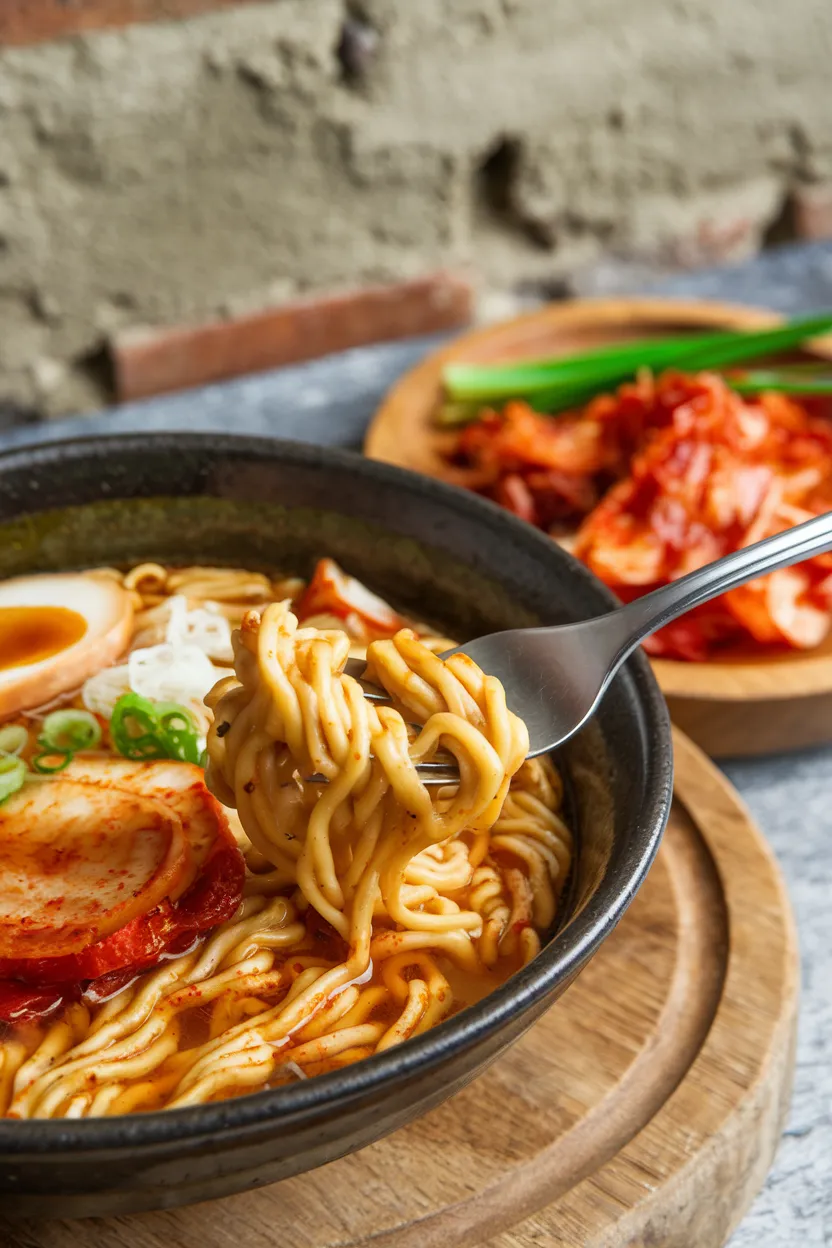
I revel in a gochujang-scented, steamy bowl of ramen, where tangy, spicy kimchi intermingles with hot broth, with crunchy hints of napa cabbage, garlic and green onions. You can spin it into your own adventure, full of flavor and simplicity.

Ingredients
1 package of instant ramen noodles
1 cup of kimchi, chopped
2 cups of water
1 tablespoon of gochujang (Korean chili paste)
1 teaspoon of soy sauce
1 teaspoon of sesame oil
1 green onion, sliced
1 egg (optional)
Toasted sesame seeds (for garnish)
Instructions
1. Boil 2 cups of water in a pot. Add the gochujang and soy sauce. Stir until fully dissolved.
2. Put in the chopped kimchi and simmer for 5 minutes to let the flavors infuse.
3. Put the ramen noodles in the pot and cook according to package instructions (about 3-4 minutes)
4. Now, add the rest of the ingredients and cook for another minute.
5. If you like, add a beaten egg to the pot and allow it to poach in the simmering stock until the white has set.
6. Before serving, top the cooked ramen with a drizzle of sesame oil and sprinkle with sliced green onion and toasted sesame seeds.
2. Kimchi Udon
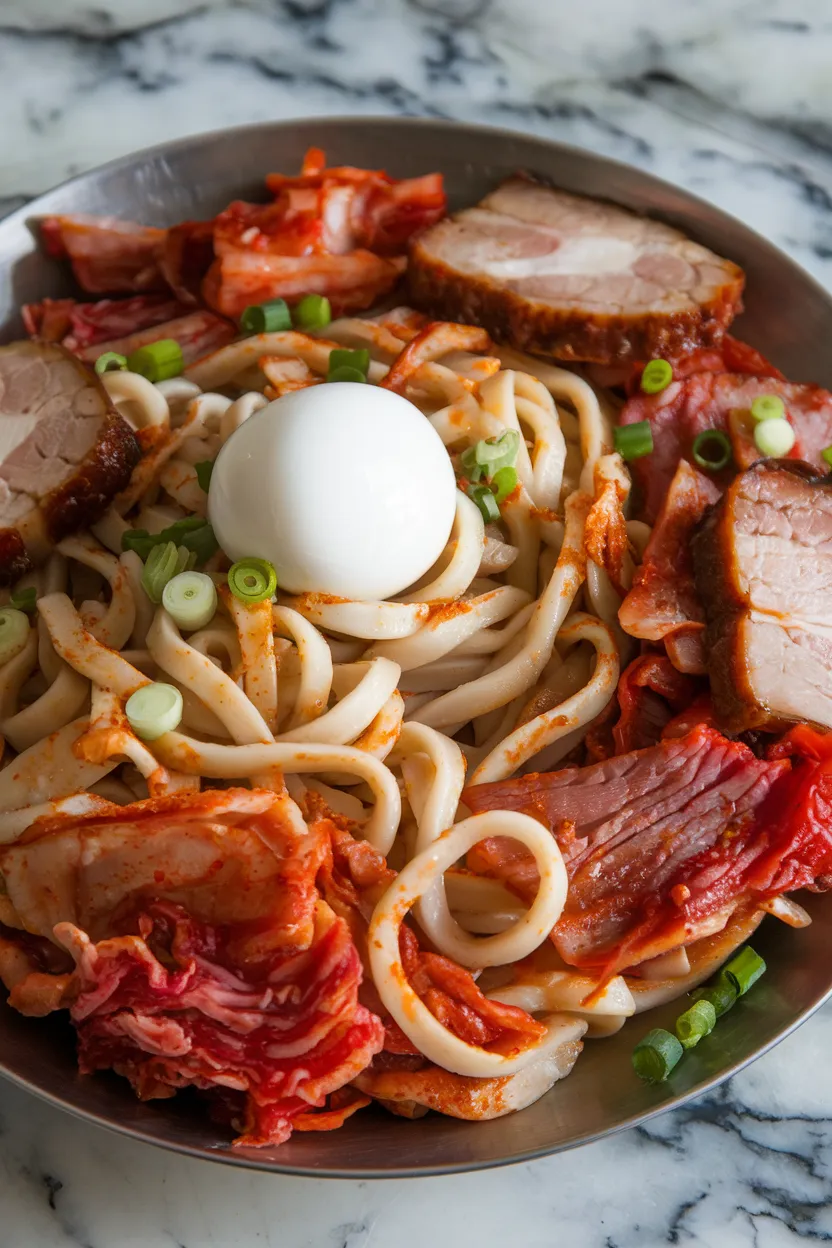
I love diving into a steamy bowl of stew, and this recipe folds tangy umami flavor’s with a fiery spice. When I make it, I like to add filling udon noodles, tangy kimchi, and juicy pork or tofu chunks.
But sometimes a splash of soy and some green onions is all I need.

Ingredients
200g udon noodles (fresh or frozen)
150g kimchi, chopped
100g pork belly, thinly sliced
1 tablespoon vegetable oil
2 tablespoons soy sauce
1 tablespoon gochujang (Korean chili paste)
1 teaspoon sesame oil
1 green onion, sliced
1 teaspoon sesame seeds
Optional: 1 soft-boiled egg
Instructions
1. Cook the udon noodles according to package instructions. Drain and set aside.
2. Heat the vegetable oil in a sauté pan over medium heat and sear the pork belly until cooked all the way through and browned.
3. Add the chopped kimchi and cook for 2-3 minutes until fragrant and softened.
4. Drop in the cooked noodles and stir in soy sauce, gochujang and sesame oil, until the noodles are all coated.
5. Serve hot with green onion, sesame seeds and an optional soft-boiled egg.
3. Kimchi Soba
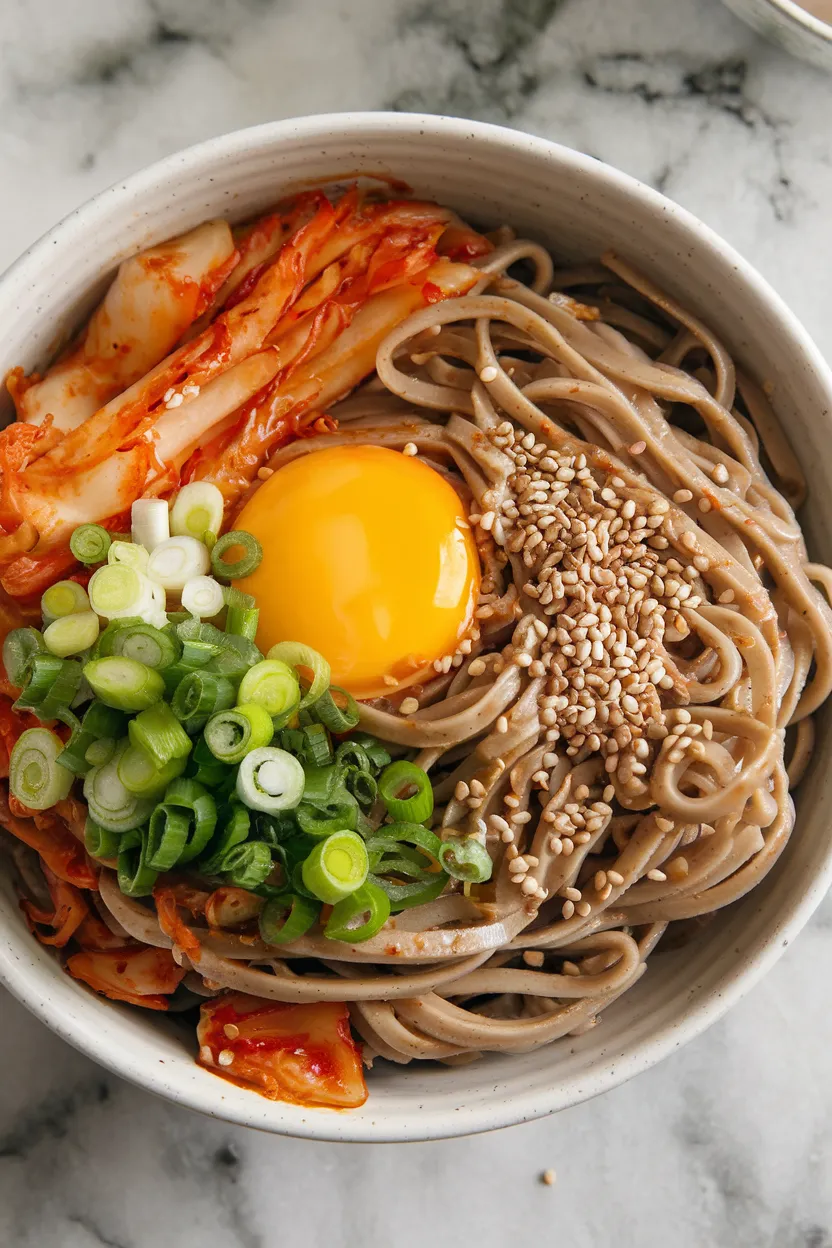
I really love cooking delicious food and think this is a perfect fusion dish, a blend of soba noodles, the spicy, sour earthiness of kimchi, with some sesame oil, soy sauce, scallions, and maybe a little garlic drizzled on top, and it’s just wonderful.

Ingredients
Buckwheat soba noodles
Napa cabbage kimchi (with its juice)
Sesame oil
Green onions (scallions), thinly sliced
Soy sauce
Rice vinegar
Sesame seeds
(Optional) Soft-boiled egg yolk
Instructions
1. Bring a large pot of water to a boil and cook the buckwheat soba noodles according to package instructions. Drain and rinse under cold water to stop the cooking process. Transfer to a large bowl.
2. In a mixing bowl, shred the kimchi and save its juice. Then add sesame oil, soy sauce and rice vinegar, and toss evenly.
3. Transfer the chilled soba noodles to the bowl, toss and distribute the noodles evenly with kimchi dressing.
4. Garnish with the sliced scallions and sesame seeds, gently stirring until they are combined.
5. Add more soy sauce or kimchi juice to taste.
6. Top, if wished, with a runny soft-boiled egg, and scatter with a few extra sesame seeds to finish.
4. Kimchi Somen
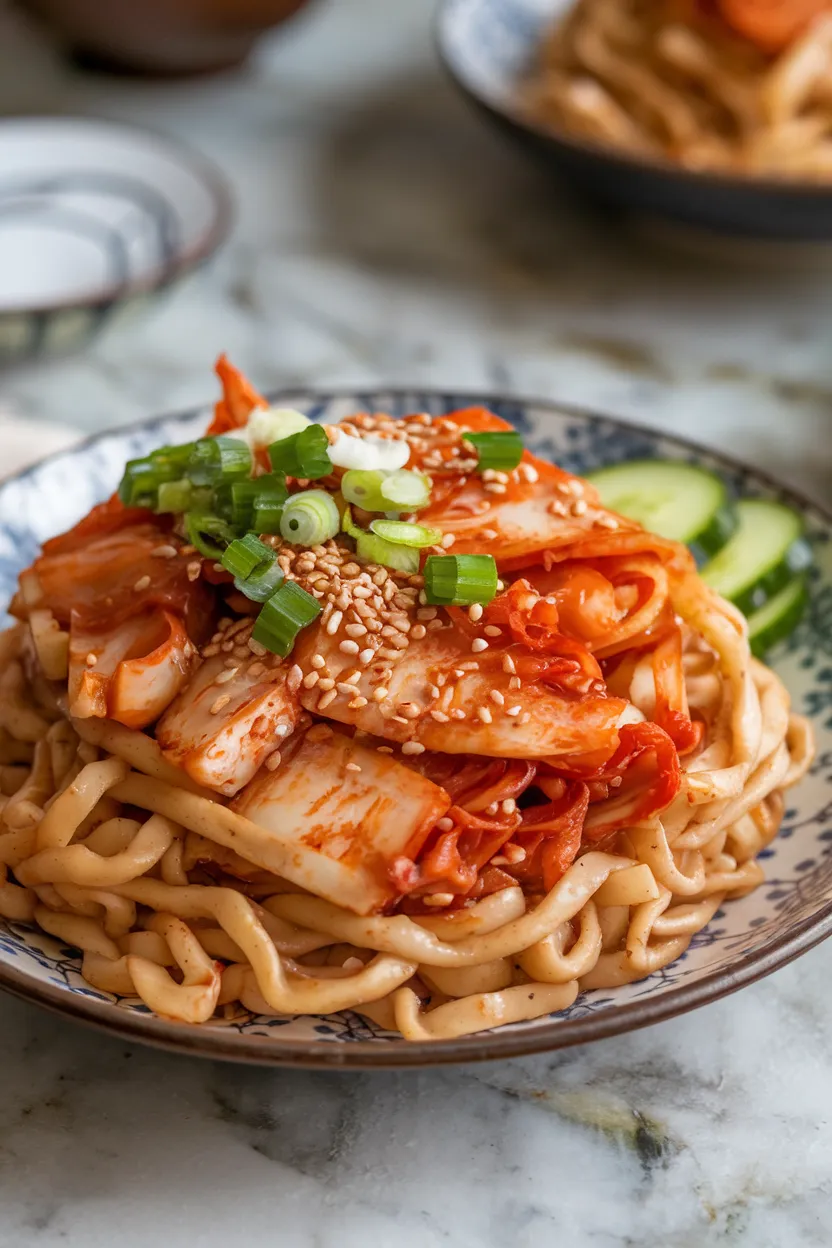
A noodle dish of many flavors in Korean cuisine is my favorite; spicy kimchi, cool slices of cucumber and delicate somen noodles (mine always has sesame oil and soya sauce).

Ingredients
200 grams somen noodles
1 cup kimchi, chopped
1 tablespoon kimchi juice
1 tablespoon soy sauce
1 tablespoon rice vinegar
1 tablespoon sesame oil
1 teaspoon sugar
1 medium cucumber, julienned
1 green onion, sliced
1 tablespoon toasted sesame seeds
1 soft-boiled egg (optional, for serving)
Instructions
1. Cook the somen noodles according to package instructions. Rinse with cold water to stop the cooking process and drain.
2. In a large bowl, toss the noodles with the dressing.
3. Garnish with the ginger, scallions and cilantro. Serve on a medium serving plate.
2. Combine the chopped kimchi and reserved kimchi juice in a bowl with the soy sauce, rice vinegar, sesame oil and sugar until well blended.
3. Toss the drained cooked somen noodles with kimchi mixture until everything is combined and noodles are coated.
4. Mix in the julienned cucumber and green onion, and toss gently and delicately to combine.
5. Place the noodles into a serving dish and sprinkle with toasted sesame seeds. Slice a soft-boiled egg on top, if using.
6. Serve immediately as a refreshing and spicy cold noodle dish.
5. Kimchi Japchae
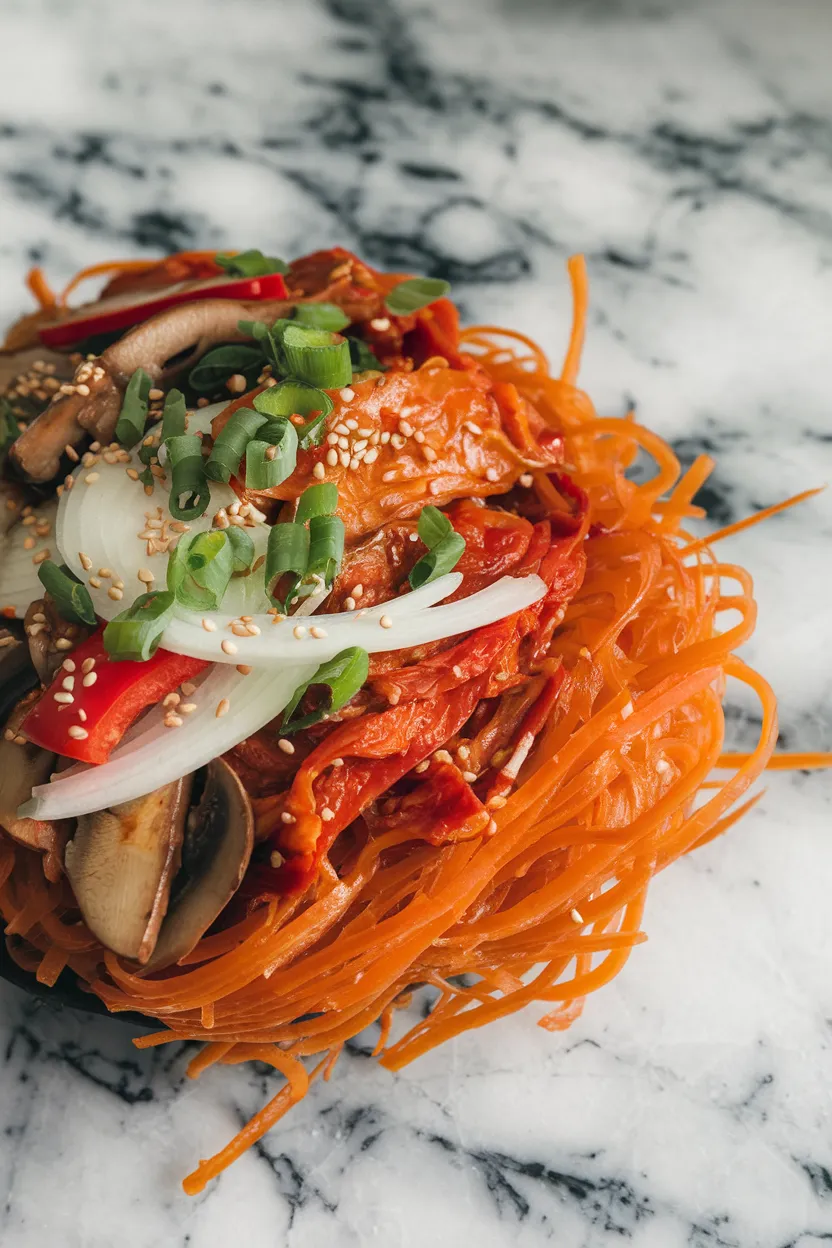
This is one of my favorite dishes to make when I can find all the ingredients, as it combines sweet and hot together in one perfect noodle dish: Korean-inspired glass noodles. I love using sweet potato noodles, colorful bell peppers, silky sautéed onions and some spicy kimchi.

Ingredients
Sweet potato glass noodles (dangmyeon)
Kimchi, chopped
Kimchi juice
Sesame oil
Soy sauce
Sugar
Garlic, minced
Carrot, julienned
Onion, sliced
Spinach or other leafy greens
Red bell pepper, sliced
Mushrooms, sliced
Sesame seeds
Spring onions, chopped
Vegetable oil
Instructions
Step 1: Cook the sweet potato glass noodles according to package instructions. Drain and rinse with cold water. Set aside.
2. In a large skillet over medium heat, place enough vegetable oil to coat the bottom and sauté the garlic. Continue to stir until just fragrant, then add sliced onions, carrots, red bell pepper and mushrooms, and stir-fry until vegetables are tender.
3. Add chopped kimchi and continue to fry for a few more minutes. Add the kimchi juice, soy sauce, sugar and sesame oil and stir until mixed.
4. Toss the cooked noodles with the rest of the mixture until coated and cooked through.
5. Stir in the spinach and cook until wilted. Adjust seasoning as needed.
6. Garnish with sesame seeds and chopped spring onions before serving. Serve immediately.
6. Kimchi Cold Noodles
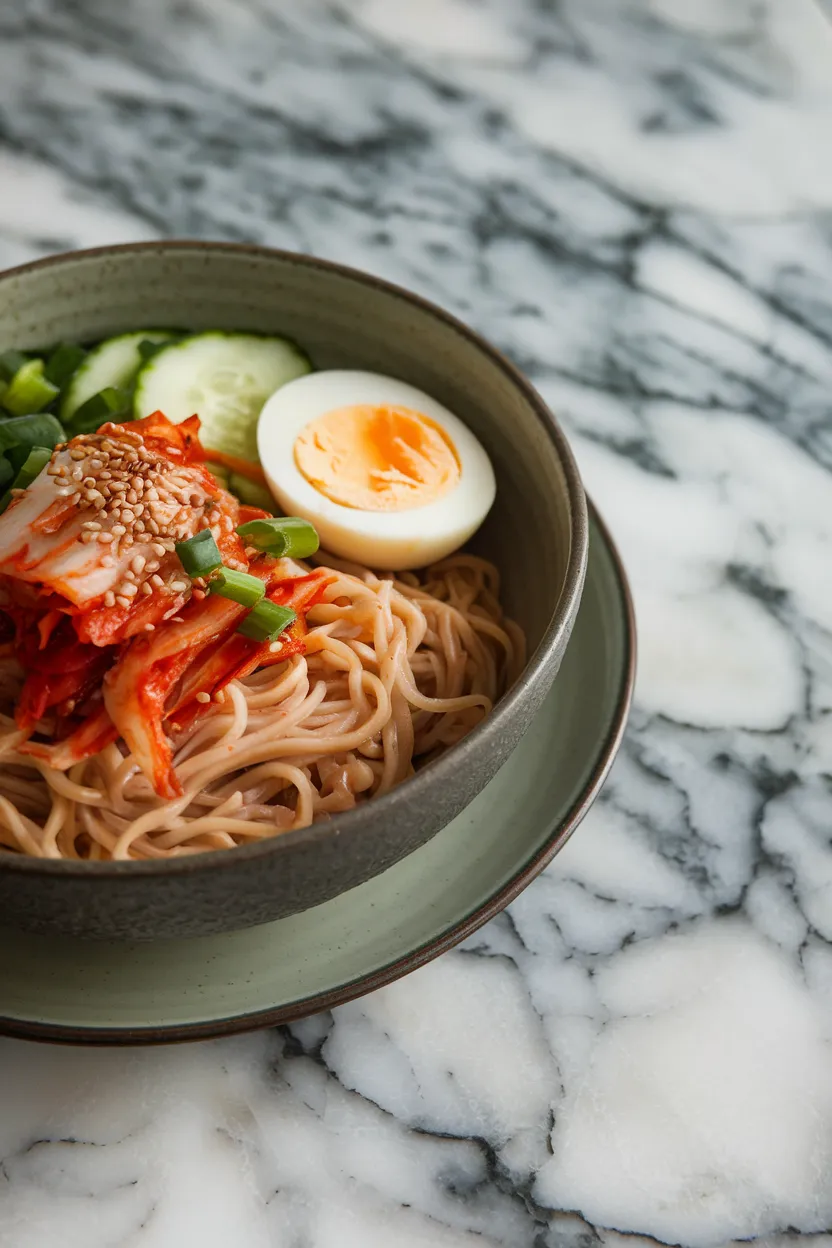
This is a dish I love to eat, especially when it’s loaded with a variety of brightly colored ingredients. It could have chewy noodles, fiery kimchi, crisp cucumber, and savory sesame oil with some garlic and a scatter of green onions.
Sometimes I like to top it with half a boiled egg. I am a sucker for spicy, cold food.

Ingredients
200 grams of buckwheat noodles (soba or naengmyeon noodles)
1 cup of kimchi, chopped into small pieces
1/2 cup of kimchi juice
1 cucumber, julienned
1 hard-boiled egg, halved
1 tablespoon gochujang (Korean red chili paste)
1 tablespoon soy sauce
1 tablespoon rice vinegar
1 teaspoon sugar
1 tablespoon sesame oil
1 tablespoon roasted sesame seeds
2 green onions, finely chopped
Ice cubes
Instructions
1. Cook the buckwheat noodles according to package instructions, rinse under cold water and drain well.
2. In a large bowl, mix together the kimchi and kimchi juice, gochujang, soy sauce, rice vinegar, sugar and sesame oil until well-mixed and you have a spicy kimchi sauce.
3. Add the cooked noodles to the kimchi sauce, and toss the noodles gently until they’re well coated with the sauce.
4. Put noodles in to serving bowls and add a few ice cubes at the bottom of each bowl to keep noodles cool.
5. Divide the noodles and sauce among the bowls. Garnish with cucumber, halved hard-boiled egg, sliced green onions and roasted sesame seeds.
6. Serve immediately and enjoy your refreshing and tangy Kimchi Cold Noodles!
7. Kimchi Spaghetti
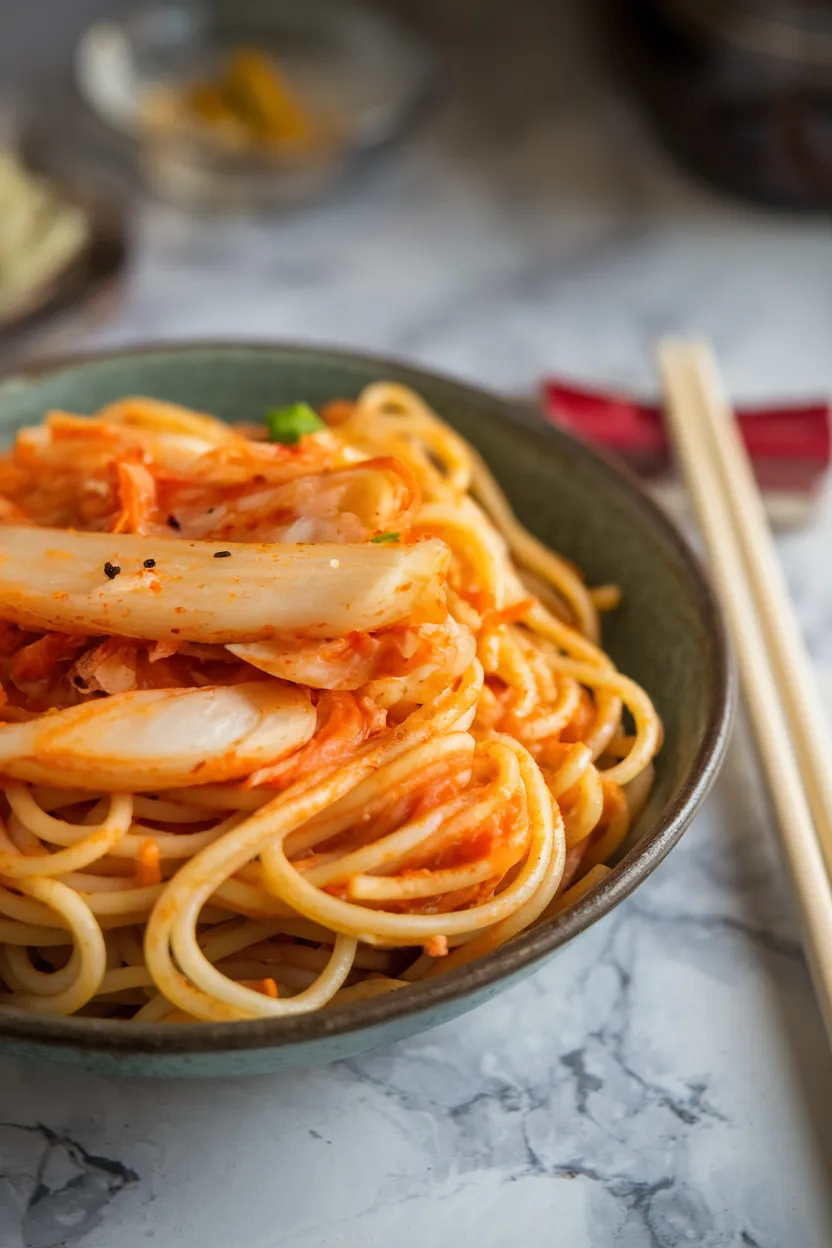
I finally got both of them together with this Korean twist of mine, a recipe I am fond of. I always like a bit of kick with my pasta, so spaghetti with kimchi and a bit of chilli flakes is perfect to me..

Ingredients
8 oz spaghetti
1 tablespoon vegetable oil
2 garlic cloves, minced
1 cup kimchi, chopped
2 tablespoons gochujang (Korean red pepper paste)
2 tablespoons soy sauce
1 tablespoon sesame oil
1 tablespoon sugar
2 green onions, thinly sliced
1 tablespoon toasted sesame seeds
Instructions
1. Cook spaghetti in salted water according to package instructions until al dente.
2. Drain, then place aside.
2. In a large skillet, heat vegetable oil over medium heat, then stir in the minced garlic and cook for about half a minute until fragrant.
3. Add the kimchi, chopped, to the skillet and cook for 2-3 minutes until it softens a bit.
4. Add the gochujang, soy sauce, sesame oil and sugar, and whisk to combine.
5. Toss in the cooked spaghetti and coat with the kimchi mixture until well coated and heated through.
6. Serve the kimchi spaghetti garnished with sliced green onions and toasted sesame seeds.
8. Kimchi Glass Noodles

A nice dish I have ever eaten combines spice, texture and a complexity of flavors. It contains glass noodles that are simultaneously chewy and succulent, spicy kimchi, crunchy vegetables and garlic.
It could really do with sesame seeds and a dash of soy sauce.

Ingredients
8 ounces of glass noodles (dangmyeon or vermicelli)
1 cup of kimchi, chopped
2 tablespoons of kimchi juice
2 tablespoons of soy sauce
1 tablespoon of sesame oil
1 tablespoon of vegetable oil
1 clove of garlic, minced
1 teaspoon of sugar
1/2 cup of carrots, julienned
1/2 cup of spinach or other leafy greens
2 green onions, chopped
Sesame seeds for garnish
Instructions
1. While the water is heating for the noodles, place the glass noodles in a large mixing bowl. When the water is boiling, pour it over the noodles and let soak for two minutes, or until the noodles are tender. Drain and rinse under cold water, then set aside.
2. Heat the vegetable oil over a medium flame in a large pan and once hot, add the garlic. Cook until fragrant.
3. Stir in the kimchi and carrots. Cook for 3 minutes.
4. Pour the now cooked noodles into the pan and add the kimchi juice, soy sauce, sesame oil and sugar. Mix everything together to coat evenly.
5. Add the spinach and green onions, and cook for 2-3 minutes until the greens have wilted.
6. Transfer to a serving dish, sprinkle with sesame seeds, and serve warm.
9. Kimchi Stir-Fry Noodles
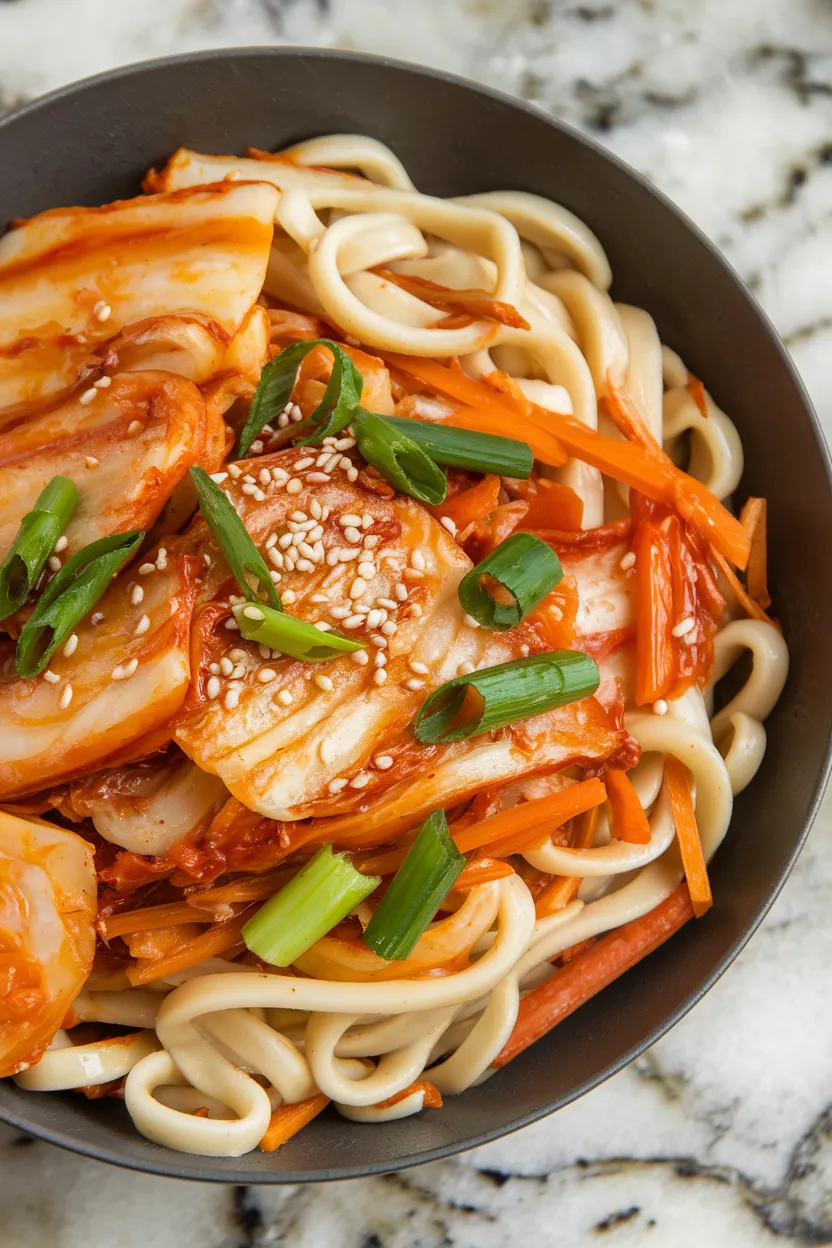
Full of fiery flavors and satisfyingly hearty, this is the dish I reach for when I’m in the mood for something cozy yet exhilarating. Tangy kimchi, salt and soy,, carrot and a sprinkle of sesame seeds on top.
Delicious.

Ingredients
8 ounces of udon noodles
1 cup kimchi, chopped
1 tablespoon vegetable oil
2 garlic cloves, minced
1 small onion, sliced
1 carrot, julienned
1 tablespoon soy sauce
1 tablespoon gochujang (Korean chili paste)
1 teaspoon sesame oil
2 scallions, sliced
Sesame seeds, for garnish
Instructions
1. Cook the udon noodles according to package instructions. Drain and set aside.
2. In a large skillet over medium heat, sauté the garlic and onion in vegetable oil until the onion is translucent.
3. Place the carrot and diced kimchi into skillet. Cook over medium heat until the carrot softens.
4. Toss in the cooked noodles, soy sauce and gochujang. Stir well to coat the noodles and heat everything through.
5. Drizzle with sesame oil and toss in the scallions.
6. Serve hot, garnished with sesame seeds.
10. Kimchi Ramen
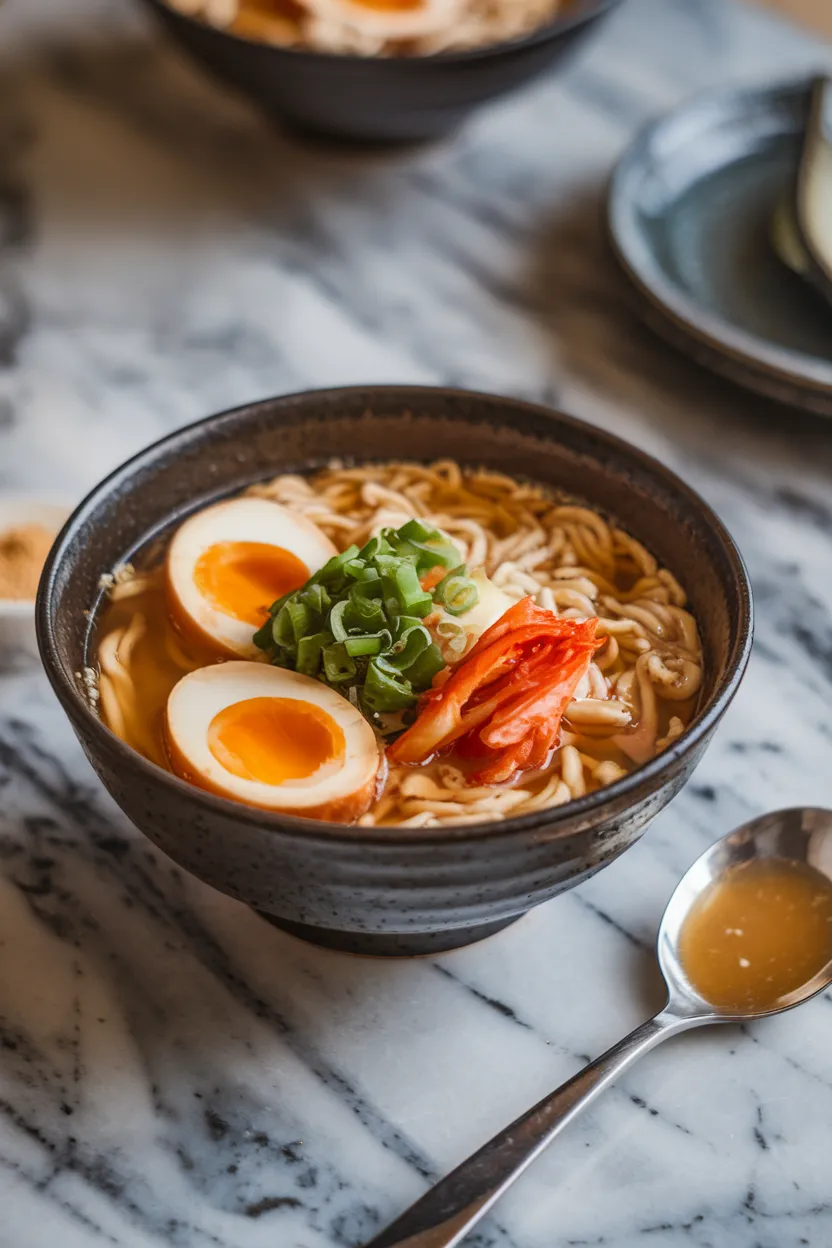
There is nothing quite as comforting as a bowl of steaming noodles, enveloped with the gentle embrace of vibrant hues of kimchi, springy ramen noodles and spicy gochujang and tickled lightly with sesame oil. This dish is simply irresistible and the flavours and textures combinations are perfect for all meal.

Ingredients
200g ramen noodles
1 cup kimchi, chopped
2 cups chicken or vegetable broth
1 tablespoon gochujang (Korean red pepper paste)
1 tablespoon soy sauce
1 teaspoon sesame oil
100g tofu, cubed or 100g sliced pork belly (optional)
2 green onions, chopped
1 soft-boiled egg (optional)
Sesame seeds for garnish
Instructions
1. In a pot, bring the chicken or vegetable broth to simmer, add the chopped kimchi and simmer for about 5 mins until it is tender.
2. Add the gochujang, soy sauce, and sesame oil, and mix until the flavors are well-mixed.
2. Add the gochujang, soy sauce, and sesame oil, and mix until well-mixed.
3. Place the ramen noodles in the pot and cook according to the package instructions, usually about 3-4 minutes until the noodles are tender.
4. If eating, add tofu, cubed or pork belly, sliced, and heat through.
5. Ladle the cooked ramen and broth into bowls, then garnish with green onions, a soft-boiled egg, and sesame seeds.
6. Serve hot.
11. Kimchi Pasta
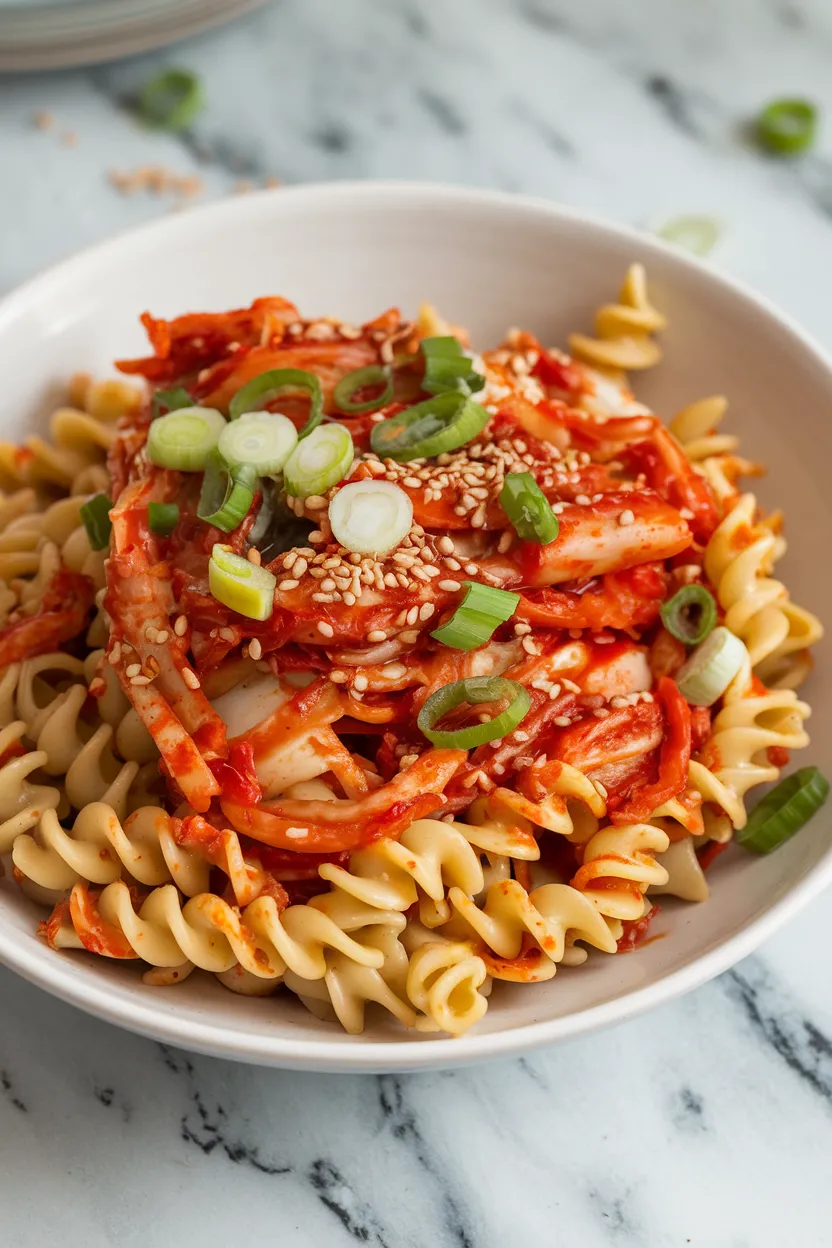
When I imagine something new I can create, I think of pasta tossed with kimchi. Kimchi and pasta is such a fun twist on classic flavors, combining the spicy brightness of the kimchi with something rich and hearty, like pasta.

Ingredients
8 ounces (about 225 grams) spaghetti or your choice of pasta
1 tablespoon sesame oil
1 tablespoon vegetable oil
1 cup kimchi, chopped
2 tablespoons kimchi juice
2 cloves garlic, minced
1 tablespoon soy sauce
1 tablespoon gochujang (Korean red pepper paste)
1/4 cup pasta cooking water
2 scallions, sliced
Salt and pepper to taste
Optional: toasted sesame seeds for garnish
Instructions
1. Cook pasta according to package directions to al dente. Preserve 1/4 cup of pasta-cooking water. Drain.
2.In a large skillet, heat the sesame oil and vegetable oil over medium heat. Add the minced garlic and cook until fragrant, about 1 minute.
3. Add the chopped Kimchi to the skillet and sauté for 2-3 minutes, until it softens.
4. Add the kimchi juice, soy sauce, gochujang and reserved pasta water, and stir until the sauce is incorporated and slightly thickened.
5. Return the drained pasta to the skillet and toss well to coat in the sauce. Cook for 1-2 minutes, adding a little extra pasta water, then season with salt and pepper to taste.
6. Serve the kimchi pasta garnished with sliced scallions and/or toasted sesame seeds, if using.
12. Kimchi Pho
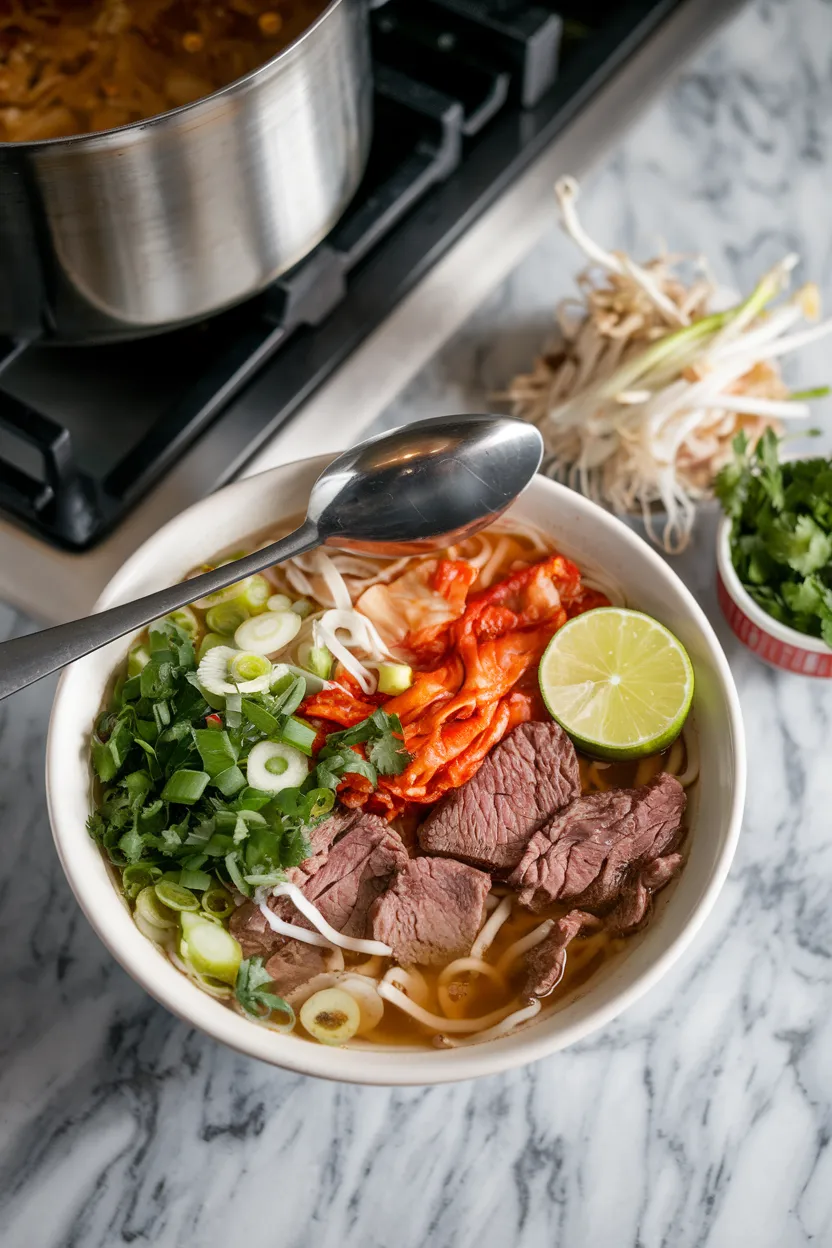
For me this dish brings together the best of Korean and Vietnamese flavor worlds, in a protein-rich combo; the bright spicy tang of a kimchi-style sauce with the fragrant punch of the broth is balanced by the heartiness of tender beef, soft rice noodles and fresh herbs, all brightened by a squeeze of lime.

Ingredients
Kimchi (1 cup, chopped)
Rice noodles (8 oz)
Beef or chicken broth (4 cups)
Sliced beef or chicken (8 oz)
Soy sauce (2 tablespoons)
Fish sauce (1 tablespoon)
Garlic (3 cloves, minced)
Ginger (1 tablespoon, minced)
Green onions (2, sliced)
Lime (1, cut into wedges)
Cilantro (a handful, chopped)
Bean sprouts (1 cup)
Sriracha or chili paste (to taste)
Instructions
1. Cook the rice noodles according to package instructions, then drain and set aside.
2. In a large saucepan, simmer the broth, and then add the garlic, ginger, soy sauce, and fish sauce.
3. Extra-large-shell brown conch shells (2 kg) add the sliced beef or chicken, and cook until just done, about 5 minutes.
4. Add the diced kimchi and simmer for 2-3 minutes to allow the flavours to meld.
5. Once the noodles are cooked, share the noodles between bowls and pour the hot broth and meat on top.
6 Squeeze with lime and garnish with green onions, cilantro, bean sprouts and a wedge of lime. Add sriracha or chili paste for heat. Serve immediately.
13. Kimchi Yakisoba
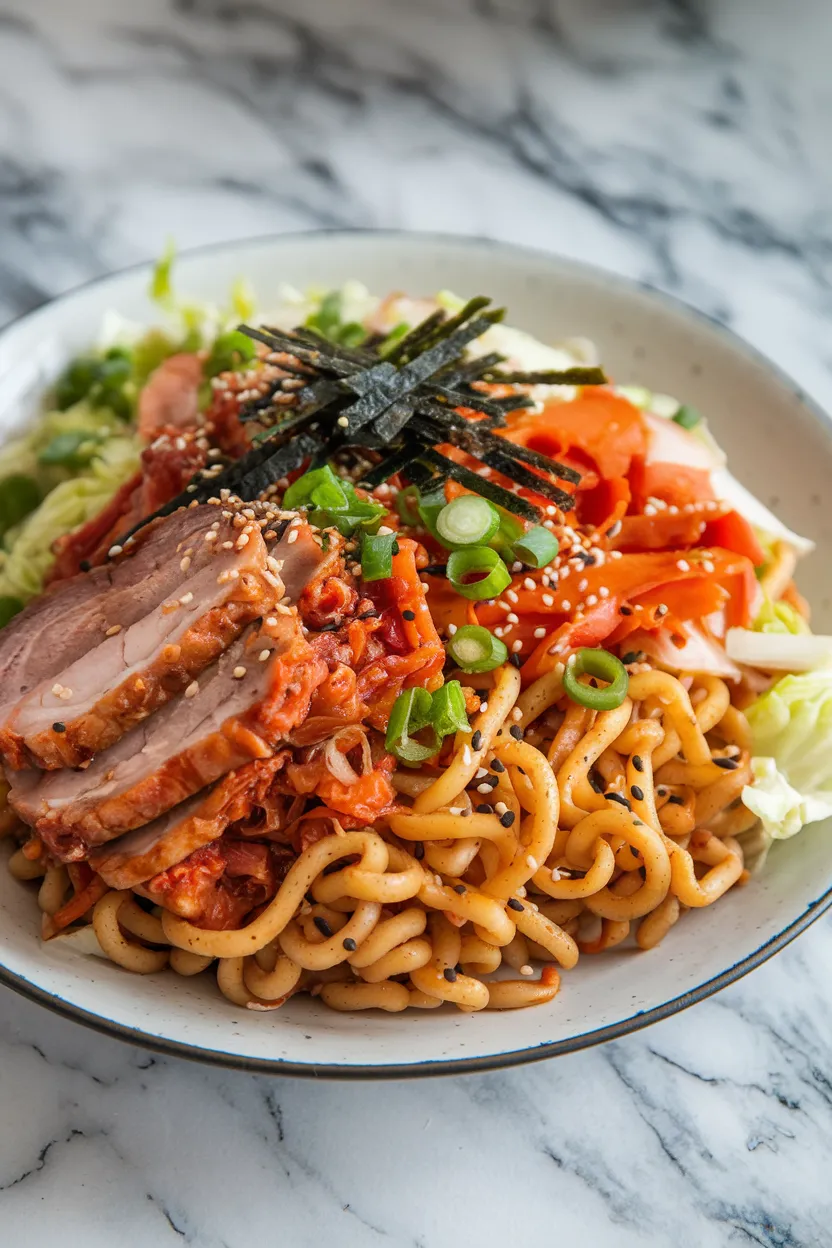
One of my favorite fusion food is the one that combines the taste of two of my favorite cuisines, Korean and Japanese. The delicious dish consists of ingredients such as kimchi, yakisoba noodles, sliced pork, carrots and green onions all stir-fried in one pot.

Ingredients
2 packs of yakisoba noodles
1 cup kimchi, chopped
150g pork belly, thinly sliced
1 small onion, sliced
1/2 cup carrots, julienned
1/2 cup cabbage, shredded
2 tablespoons yakisoba sauce
1 tablespoon vegetable oil
1 teaspoon sesame oil
2 green onions, chopped
A pinch of salt and black pepper
Optional: sesame seeds and seaweed flakes for garnish
Instructions
1. Heat the vegetable oil and sesame oil in a large pan or wok over medium heat and fry the sliced pork belly until it begins to brown.
2. Throw in the chopped onions, carrots and cabbage, stir-fry for 3-4 minute until the vegetables are a bit soft.
3. Stir to fold the chopped kimchi into the mix, and cook for another 2 minutes. 4) Open the yakisoba noodle packs, run them under warm water and loosen them up. Dump them into the pan, and combine them with the pork and vegetables.
5. Add the yakisoba sauce and toss the noodles with everything until evenly coated and heated through. Season to taste with salt and black pepper.
6. Eat hot. (Optional: Sprinkle with chopped green onions, black and white sesame seeds and seaweed flakes.)
14. Kimchi Rice Noodles
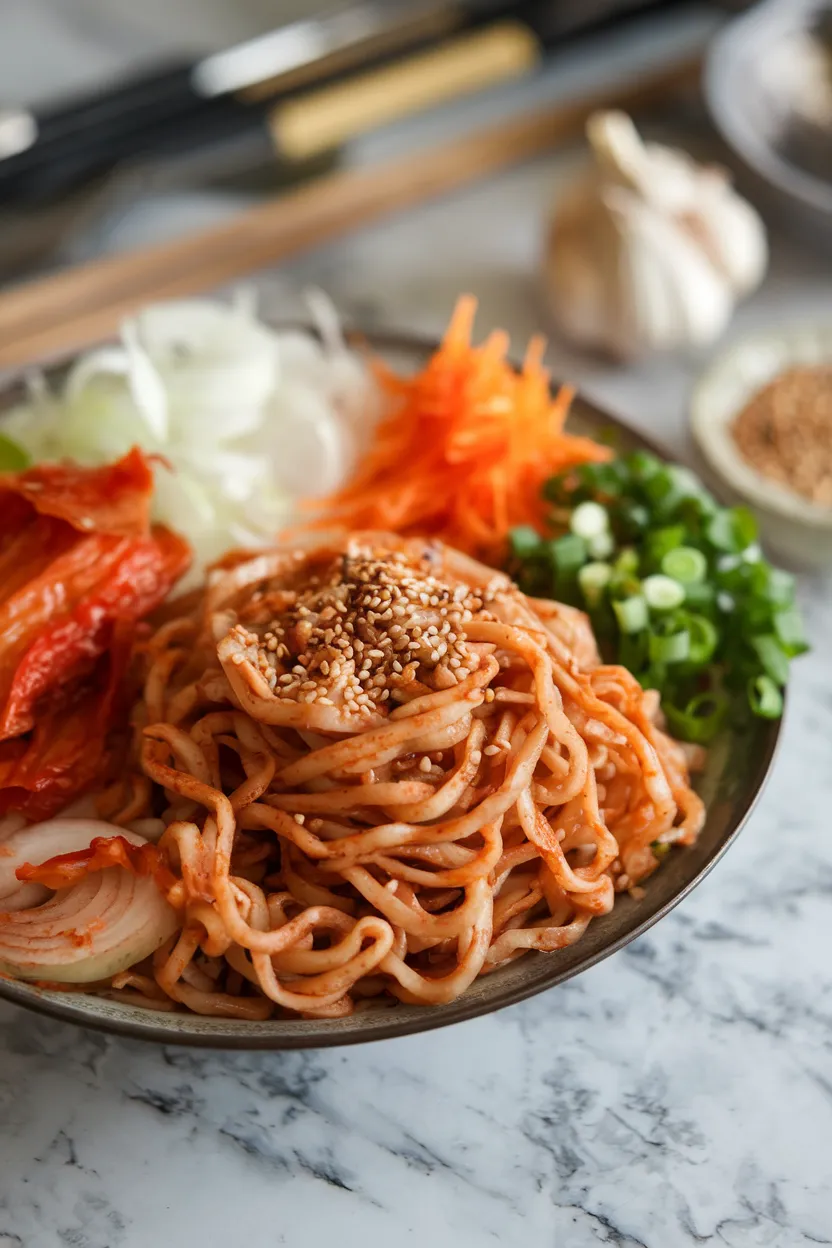
There’s something incredibly reassuring about a hot and spicy noodle bowl full of color. This is a great kimchi noodle recipe, sometimes spruced up with some green onions, a drizzle of sesame oil and toasted sesame seeds.

Ingredients
8 oz rice noodles
1 cup kimchi, chopped
2 tablespoons kimchi juice
1 tablespoon vegetable oil
1/2 onion, sliced
1 carrot, julienned
3 cloves garlic, minced
2 green onions, chopped
1 tablespoon soy sauce
1 teaspoon sesame oil
1/2 teaspoon sugar
1 tablespoon toasted sesame seeds
Instructions
1. Cook the rice noodles according to package instructions, then drain and set aside.
2. Put the vegetable oil in a big frying pan and heat over a medium heat. Add the onion, carrot and garlic and sauté until the onion is translucent.
3. Stir in the chopped kimchi and cook for 2-3 minutes until heated through.
4. Put in the cooked rice noodles, kimchi juice, soy sauce, sesame oil and sugar. Toss everything together to blend and heat up.
5. Add chopped green onions and toasted sesame seeds before serving. Kimchi Rice Noodles are enjoyed best when served hot.
15. Kimchi Buckwheat Noodles
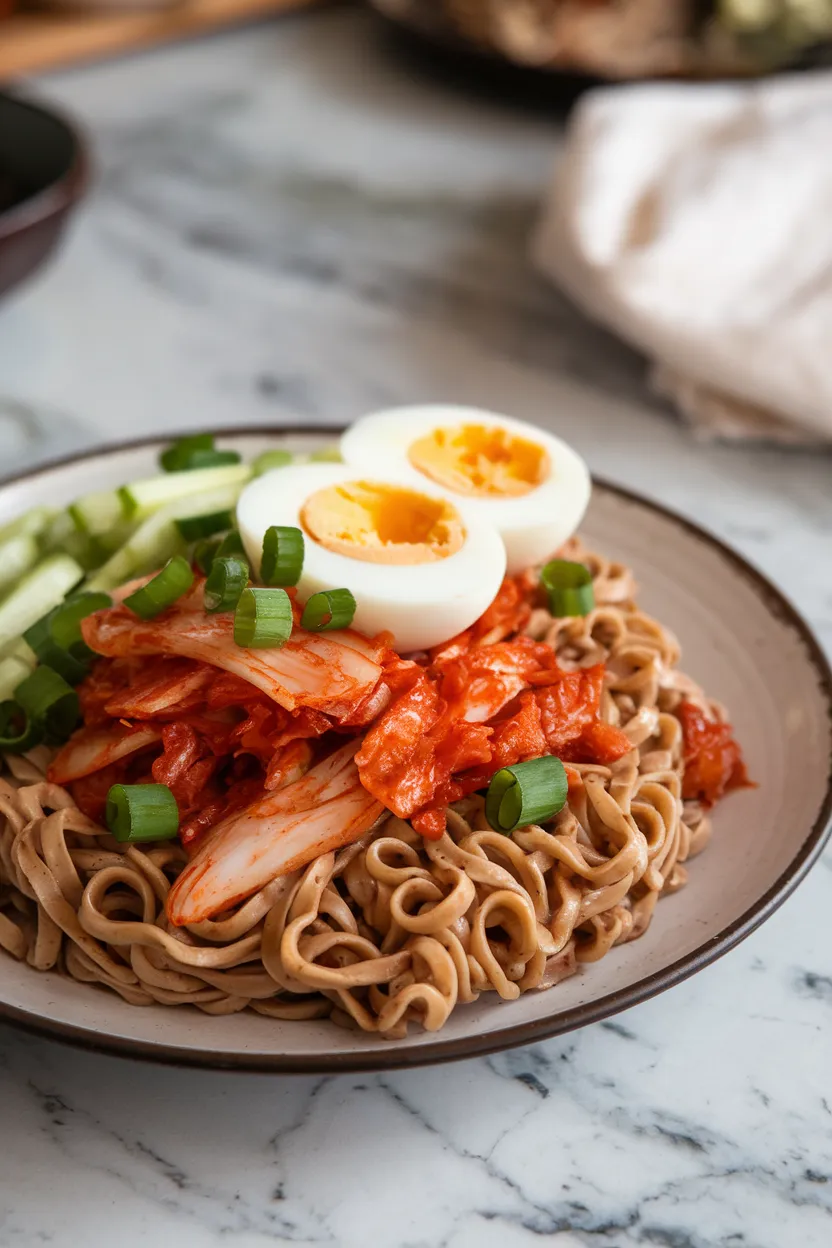
Whenever I want a nurturing dish with a lift of excitement, I think of this. Spicy kimchi.
A dark soba made from buckwheat. Slices of cucumber.

Ingredients
200g buckwheat noodles
1 cup kimchi, chopped
1 tablespoon gochujang (Korean chili paste)
1 tablespoon soy sauce
1 tablespoon sesame oil
2 tablespoons rice vinegar
1 tablespoon sugar
2 scallions, sliced
1 cucumber, julienned
1 boiled egg, halved
Sesame seeds for garnish
Instructions
1. Bring a large pan of salted water to a boil, then cook the buckwheat noodles according to the packet instructions, drain and rinse under cold water. Set aside.
2. In a large bowl, whisk together the gochujang, soy sauce, sesame oil, rice vinegar and brown sugar until smooth.
3. Add the chopped kimchi to the sauce and stir to incorporate.
4. Toss the drained noodles with the kimchi sauce until evenly coated.
5. Place the noodles, garnished with scallions, sliced cucumber, halved boiled eggs and a sprinkle of sesame seeds, on the table.

